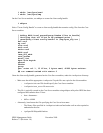
Mount Option Mount Description
acdirtimeo
Seconds to cache directory attributes. The shorter this value, the more frequently
communication to HPSS is required. Synchronization between separate vfs nodes
or mount points may benefit for a shorter cache period with the expense of longer
latencies.
flushd
The flush deamons look for data pages that need to be written to HPSS, either time
to write or data pages being requested for other files. Each daemon consumes
resources so care should be taken when changing this option. Another possibility is
to change iomax to allow more pages to be available.
rtimeo / wtimeo
Performance gains can be realized when minimizing the number of transfers. This
timeout allows multiple requests to be combined within the time limit.
rpages / wpages
Each specifies the maximum number of kernel buffer pages that can be dedicated to
individual file transfers. Care must be taken to configure this correctly to the
expected number of concurrent transfers and the iomax mount option.
iomax
Maximum number of kernel buffer pages (4096 bytes + overhead) that can be
allocated for data buffers when transferring file data. Each mount point has its own
set of data buffers. Since these pages consume RAM resources, this must be
compatible with application loads and transfer goals for the system. For instance,
the more pages allocated to the mount point, the less RAM available for
applications. This should also be consistent with rpages and wpages.
fcsize
File Cache Size. Cache this much of the file on first access. This consumes
resources so care must be taken not to make this too large. Configuring this to
typical file access patterns will speed access when large enough to cache future
requests.
san / nosan
Configures the mount point to transfer data from buffers directly to SAN devices.
shm
Shared Memory (need to look into this)
dio
Configures the mount point to transfer data to/from directly from application space.
This bypasses Linux VFS file buffering, see ???? for a discussion on advantages
that the Linux VFS buffering provides.
trace
Level of messages logged from the HPSS kernel extension to /var/log/messages.
Ranges from 0 to 5 with 0 being the least and 5 being lots.
sharefd / nosharefd
rattr
Typically short directory listings do not have to access HPSS for file attributes.
Specifying this option will force all directory listings to retrieve file attributes from
HPSS. If the application is always doing long directory listings this has no effect. If
the application always requests short directory listings, this will delay those requests
needlessly.
ip
Configure the network interfaces to use.
cos
Specify the default Class Of Service to use. This can be overridden by an ioctl()
system call once the file is created but BEFORE any data is written. Standard Linux
commands / library functions will not use the ioctl(), they will use the COS setting for
files stored in a fileset.
ro / rw
File system will be ro=read only or rw=read write.
maxsegsz
Use the maximum segment size for the storage class. If not used, the minimum
segment size is used. An application can use ioctl() to set this per file once the file is
created but BEFORE any data is written.
HPSS Management Guide November 2009
Release 7.3 (Revision 1.0) 353


















